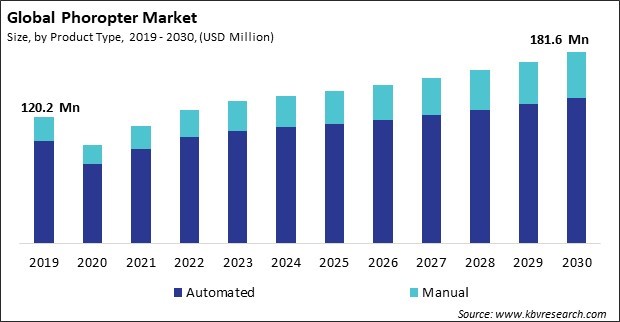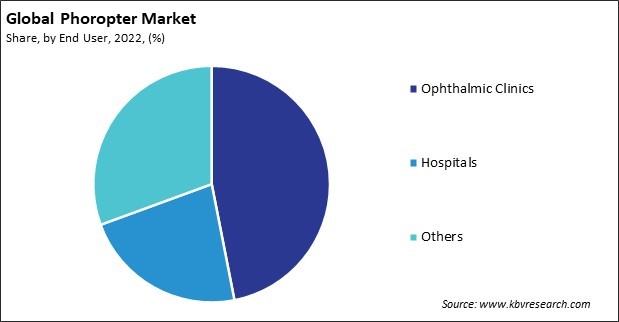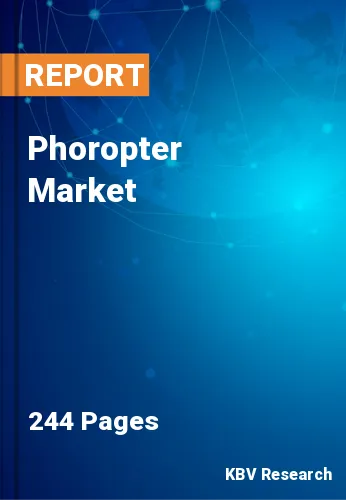“Global Phoropter Market to reach a market value of USD 181.6 Million by 2030 growing at a CAGR of 4.3%”
The Global Phoropter Market size is expected to reach $181.6 million by 2030, rising at a market growth of 4.3% CAGR during the forecast period. In the year 2022, the market attained a volume of 43,197.4 units, experiencing a growth of 3.6% (2019-2022).
Digital phoropters utilize advanced optics and digital technology to achieve precise and accurate refraction measurements. Therefore, the Automated segment acquired $1,01,235.9 thousand revenue in 2022. Making precise minute adjustments enhances the accuracy of eyeglass or contact lens prescriptions, contributing to improved patient visual outcomes. Digital phoropters streamline the refraction process, allowing eye care professionals to make quick and seamless adjustments during an eye examination. Automating certain manual tasks reduces the time required for each examination, increasing patient throughput and enhancing overall clinic efficiency.

Myopia, or nearsightedness, has notably increased, especially in urbanized and technologically advanced societies. Factors such as increased screen time, prolonged work, and limited outdoor activities contribute to the rising prevalence of myopia. Phoropters are essential for accurately measuring and correcting myopic refractive errors during eye examinations. Beyond myopia, other common refractive errors like hyperopia (farsightedness) and astigmatism also contribute to the growing burden of vision disorders. Presbyopia, an age-related condition affecting near vision, becomes more prevalent as populations age. Phoropters are indispensable in diagnosing and correcting these refractive errors, allowing eye care professionals to prescribe precise corrective lenses. Additionally, Prolonged use of digital devices such as computers, smartphones, and tablets can lead to digital eye strain. Individuals experiencing these symptoms often seek eye examinations to assess their vision and determine if corrective measures, such as prescription glasses or adjustments in screen habits, are necessary. Individuals engaged in remote activities may experience visual comfort and acuity changes, prompting them to seek eye examinations to address potential vision issues. Phoropters are key in accurately assessing refractive errors and determining the appropriate corrective prescriptions. The awareness of these effects has led to an increased demand for blue light-blocking lenses. Phoropters are instrumental in determining the optimal prescription for such lenses based on individual visual needs. Thus, these factors will boost the demand for phoropters in the upcoming years.
However, Unequal access to eye care services contributes to health disparities, with individuals in underserved communities facing challenges in receiving timely and comprehensive eye examinations. The lack of access may result in undiagnosed and untreated vision issues. Underserved communities often face barriers to preventive care, including routine eye exams. Phoropters are crucial in conducting precise refraction tests, which are fundamental for prescribing corrective lenses and detecting early signs of eye conditions. Limited access hinders the implementation of preventive eye care measures. The absence of phoropters in these areas reflects broader challenges in allocating resources for healthcare infrastructure development. Hence, these factors will decrease demand for phoropters in the coming years.
Further, restrictions on movement, lockdowns, and workforce challenges affected the production and distribution of medical equipment, including phoropters. This led to delays in manufacturing and supply chain disruptions. Healthcare providers faced financial challenges and uncertainties during the pandemic, affecting their purchasing decisions. Non-urgent expenditures, including investments in new equipment like phoropters, were delayed or reconsidered as healthcare facilities focused on immediate needs related to the pandemic response. While phoropters are traditionally used in face-to-face eye exams, shifts toward teleophthalmology or remote consultations impacted the immediate need for these devices. Thus, the COVID-19 pandemic had a negative impact on the phoropter market.
On the basis of end user, the market is divided into hospitals, ophthalmic clinics, and others. The ophthalmic clinics segment recorded the maximum revenue share in the market in 2022. The growing awareness of eye health and an aging population contribute to an increased demand for eye care services. Ophthalmic clinics are central in providing comprehensive eye examinations and vision care, driving the demand for advanced diagnostic equipment like phoropters. Hence, the segment will expand rapidly in the upcoming years.

Based on product type, the market is segmented into manual and automated. In 2022, the manual segment garnered a significant revenue share in the market. Manual phoropters are often considered more cost-effective compared to their digital counterparts. In settings where budget constraints are a significant factor, eye care practices, especially smaller ones, may opt for manual phoropters as they provide essential functionality at a lower initial cost. These factors can contribute to the growth of the segment in the upcoming years.
Free Valuable Insights: Global Phoropter Market size to reach USD 181.6 Million by 2030
By region, the market is segmented into North America, Europe, Asia Pacific, and LAMEA. The North America segment procured the highest revenue share in the market in 2022. The prevalence of vision disorders, including refractive errors, in North America has driven the demand for precise diagnostic tools. Phoropters play a key role in determining the correct prescription for eyeglasses and identifying vision issues, leading to increased adoption. Therefore, these factors will pose lucrative growth prospects for the segment.
| Report Attribute | Details |
|---|---|
| Market size value in 2022 | USD 127.1 Million |
| Market size forecast in 2030 | USD 181.6 Million |
| Base Year | 2022 |
| Historical Period | 2019 to 2021 |
| Forecast Period | 2023 to 2030 |
| Revenue Growth Rate | CAGR of 4.3% from 2023 to 2030 |
| Number of Pages | 244 |
| Number of Table | 490 |
| Quantitative Data | Volume in Units, Revenue in USD Million, and CAGR from 2019 to 2030 |
| Report coverage | Market Trends, Revenue Estimation and Forecast, Segmentation Analysis, Regional and Country Breakdown, Porter’s 5 Forces Analysis, Company Profiling, Companies Strategic Developments, SWOT Analysis, Winning Imperatives |
| Segments covered | Product Type, End User, Region |
| Country scope |
|
| Companies Included | Topcon Corporation, Nidek Co., Ltd., Reichert, Inc. (Ametek, Inc.), Carl Zeiss AG, EssilorLuxottica SA (Essilor Instruments USA), Visionix Ltd., Alcon, Inc., bon Optic Vertriebsgesellschaft mbH., Hoya Corporation, US Ophthalmic, LLC |
By Product Type (Volume, units, USD Million, 2019-2030)
By End User (Volume, units, USD Million, 2019-2030)
By Geography (Volume, units, USD Million, 2019-2030)
This Market size is expected to reach $181.6 million by 2030.
Increasing incidence of vision disorders are driving the Market in coming years, however, Limited access to eye care in several regions restraints the growth of the Market.
Topcon Corporation, Nidek Co., Ltd., Reichert, Inc. (Ametek, Inc.), Carl Zeiss AG, EssilorLuxottica SA (Essilor Instruments USA), Visionix Ltd., Alcon, Inc., bon Optic Vertriebsgesellschaft mbH., Hoya Corporation, US Ophthalmic, LLC
In the year 2022, the market attained a volume of 43,197.4 units, experiencing a growth of 3.6% (2019-2022).
The Automated segment is leading the Market, by Product Type in 2022; there by, achieving a market value of $138.5 million by 2030.
The North America region dominated the Market, by Region in 2022, and would continue to be a dominant market till 2030; there by, achieving a market value of $70.1 million by 2030.
Our team of dedicated experts can provide you with attractive expansion opportunities for your business.

 Drivers
Drivers
 Restraints
Restraints
 Opportunities
Opportunities
 Challenges
Challenges
